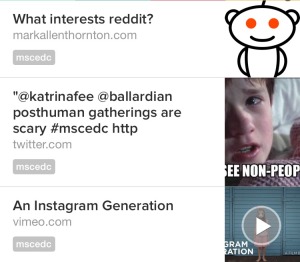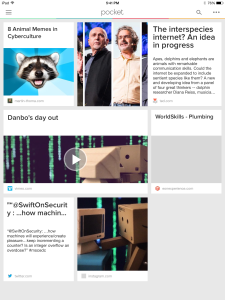Several themes emerged as I tried to summarize and reflect on my participation in this course.
Learning in the open: blogging, tweeting and exchanging resources
Blogging anchored my learning throughout the course, gave me a structure and a schedule to follow. I was initially hesitant to post half-formed ideas publicly, but as the course ran and as I found myself returning to themes and topics I had written about earlier, I found blogging a good way to track my progress. The openness was most helpful when my classmates and I responded to each other’s block assignments. I learned from how they interpreted the same assignment and worked with the same ideas.
Tweeting allowed us to exchange resources but IFTTT for my taste cluttered more than cleared up my lifestream, so I am happy that categorising the posts allowed balance between capturing my engagement and showing progress.
Multimodal opportunities
The opportunity to improve multimodal skills through practice was one of the main reasons I enrolled in this course. While tutors encouraged us to submit digital artefacts for our block assignments, the richness of the course topics themselves provided lots of visual inspiration, practically inviting multimodal play. This is especially true for cyborgs and robots we discussed in Block 1 and algorithms and analytics in Block 3. This richness allowed me to play with different formats: through sketch notes, videos and data visualization.
Although it was at the start of the course, I consider the creating the video Danbo’s day out one of my personal highlights, an example of not just illustrating an idea visually but also interpreting it. By making the video as interesting as I could, I was able to invite multiple interpretations from the audience. Combining this interestingness with an academic argument is one thing I am keen to explore in the final assignment for the course.
A critical attitude towards technology
Looking at cyber, community and algorithmic cultures impressed on me a different perspective on technology. In Block 1, I learned that we humans are not separate from our tools, and that humans and technology are mutually determining.
As an online trainer, I found it tempting to focus solely on the affordances of technology and the constant hype about what technology could offer. How could we use technology to make learning more effective and engaging? However, there is an alternative to this instrumentalist view. Technology represents not just a set of tools but also the product of toolmaking, that is, they represent a particular set of human values, judgements, decisions and negotiations. These idea was introduced in Block 1 and exemplified for me in Block 3 during the discussion on algorithms and data visualizations. Commercial interests cloak the mechanics of algorithms in secrecy. Left unquestioned, algorithms could mislead. What kind of data gets captured, how they are analysed and represented is based on social processes. Prying into this hidden social processes leads to a more nuanced understanding of technology. This allows us to see where technology fails to meet our aspirations and values as educators, and where technology leads to unintended consequences.

